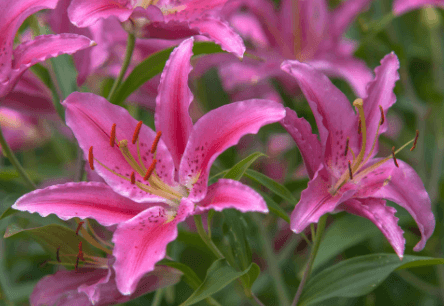Lilies are among the most beautiful flowers in the world, and pink lilies, in particular, have an undeniable charm. They come in many varieties, each with its unique shades of pink, shapes, and sizes. If you are looking for a way to add some color and elegance to your garden, pink lilies are an excellent choice. In this post, we’ll take a look at 15 stunning types of pink lilies that you can plant in your garden.

- Pink Oriental Lilies
- Lily Stargazer
- Trumpet Lilies
- Casa Blanca Lilies
- Pink Pixie Lilies
- Pink Perfection Lilies
- pink calla lilies
- Pink Aroma Lilies
- Pink Showstopper Lilies
- Pink Pearl Lilies
- Pink Martagon Lilies
- Pink Pearl Lilies
- Pink Ribbon Lilies
- Pink Ginger Lilies
- Pink Crown Lilies
- Pink Pearl Jessica Lilies
- Pink Turk’s Cap Lilies
- Pink Peony Lilies
- Pink Turk’s Cap Lilies
- Pink Carpet Lilies
- Pink Striped Lilies
How to Grow for Pink Lilies
Soil Requirements
- Choose a site with full sun exposure and well-drained soil
- Dig a hole two to three times bigger than the root ball of the plant
- Add compost or soil conditioner to enrich the soil
- Place lily in the hole and fill in with soil
- Gently pat down the dirt around your lily and water thoroughly
- Apply a layer of mulch
Water & Light Requirements
- Provide plenty of light for healthy growth
- Water regularly throughout their growing season (spring until autumn)
- Ensure adequate moisture especially during dry spells by adding organic matter to the soil if needed
Fertilizer & Pruning Instructions
- Spread slow release fertilizer around lily plants during planting time
- Prune back dead flowers promptly to ensure optimal bloom performance over time.
Pests & Disease Control
- Use neem oil or other forms of insecticides when pest infestation is detected.
- Avoid overcrowding as this could lead to fungal diseases such as powdery mildew.
- Remove any infected leaves, stems, or debris from around the plant immediately.
Common Issues with Pink Lilies
Overwatering & Root Rot
One of the most common issues with pink lilies is overwatering, which can lead to root rot and other health problems. Make sure you know what type of soil your lily is planted in, as well as its water requirements and how often it needs to be watered. When in doubt, err on the side of caution and don’t add too much water.
Pests & Diseases
Like any plant, pink lilies are susceptible to various pests and disease problems such as powdery mildew, red spider mites, aphids, and thrips. Keeping an eye out for signs of infestation or infection (such as yellowed or spotted leaves) is key to preventing further damage to your plants.
Poor Fertilization & Lack of Mulch
Not providing enough nutrients or mulch for your pink lilies can lead to stunted growth or even death. Ensure that you’re using a quality fertilizer when planting and adding a layer of mulch around the base – this helps retain moisture in the soil which is essential for the health of your plants.
Caring for Pink Lilies After Growing
Ensuring Proper Hydration
It’s important to give your pink lilies plenty of light and just the right amount of water over their growing season (from spring until autumn). While they like having moist soil, ensure that you don’t overwater them – they don’t like wet feet!
Fertilizing & Mulching
When planting, use a slow-release fertilizer as well as some compost or soil conditioner for an added nutrient boost. Adding mulch around the base of your lily plant will also help insulate it against temperature fluctuations while retaining moisture in the soil and providing further nourishment.
Pruning & Deadheading
For optimum bloom results, make sure to remove any dead or wilted flowers promptly. This is known as deadheading and is an essential step to encourage further blooms from your pink lilies throughout their growing season. Additionally, remember to prune away any diseased leaves or stems regularly.
Routine Inspections
Routine maintenance checks should be done on a regular basis to identify potential problems such as powdery mildew or red spider mites early on, allowing you to treat the issue before it gets out of hand.
Tips for Reviving Pink Lilies
- Make sure you’re providing adequate sunlight, water, and nutrients – these are key to your lily’s health and growth.
- Check for signs of pests or disease and take measures to treat them as soon as you can.
- Don’t overwater – wet feet can lead to root rot which can seriously harm your plants.
- Regularly prune away diseased leaves or stems to prevent any further damage.
- Mulch around the base of your plant in order to retain moisture in the soil and provide further nourishment.
Conclusion
In conclusion, pink lilies are a wonderful addition to any garden or outdoor space. Their vibrant colors and delicate petals add a beautiful touch of nature that can be enjoyed all season long. With the right amount of care and attention, you can ensure your pink lilies have a long and happy life in your outdoor area.
More Information
Pink lilies prefer moist soil and should be watered approximately 2-3 times per week.
Pink lilies can be prone to fungal infections such as powdery mildew and botrytis blight, particularly in high humidity. It is important to regularly inspect and treat your plants if any signs of infection appear.
Yes, you can overwinter pink lilies by providing shelter from frost and extreme temperatures. In colder climates, it is best to dig up the bulbs before winter and store them indoors, then replant them in the spring when conditions are more suitable.
Pink lilies prefer well-draining soil that is rich in organic matter and slightly acidic (pH 6 to 6.5). Adding compost or aged manure will help provide the necessary nutrients that enable healthy growth throughout the season.